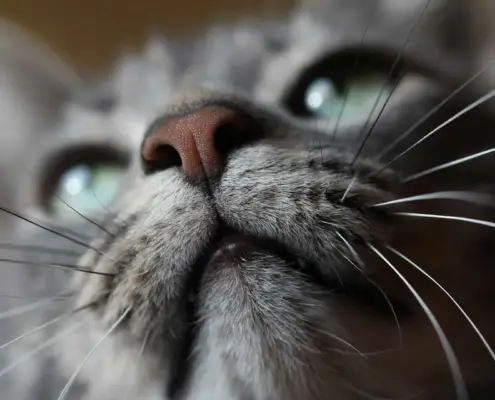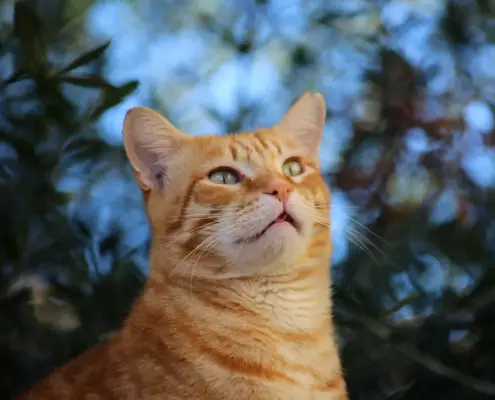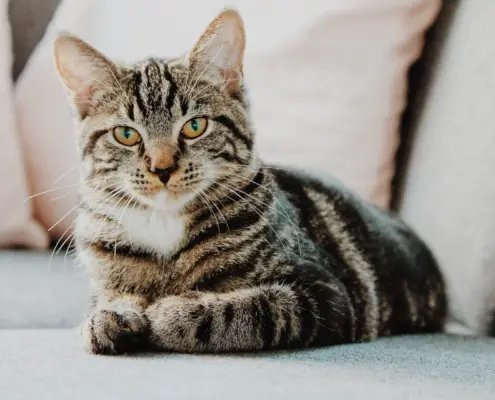
Cats are known for their graceful and flexible movements, and one of the behaviors that exemplify this is their love for stretching. From the moment they wake up to when they settle down for a nap, cats engage in a series of elaborate stretches that seem to bring them immense satisfaction. But why do cats love to stretch? To understand this fascinating habit, it is important to delve into the natural behavior of stretching in cats.
Stretching is an innate behavior in cats that serves multiple purposes. It helps them maintain their flexibility, keeps their muscles toned, and enhances their overall physical well-being. When a cat stretches, it elongates its body, extending its legs and torso to their full extent. This action provides a gentle stretch to the muscles and tendons, promoting blood circulation and preventing stiffness. Additionally, stretching helps cats to release any tension or stress they may be feeling, allowing them to relax and unwind.
The benefits of stretching for cats
Stretching offers numerous benefits to cats, both physically and mentally. Firstly, it helps to improve their range of motion and keeps their joints supple. This is particularly important for older cats who may develop arthritis or other joint-related issues. Regular stretching helps to alleviate stiffness and maintain their mobility, ensuring they can continue to move with ease.
Moreover, stretching aids in maintaining a healthy weight for cats. By engaging in a full-body stretch, cats activate their muscles and burn calories. This is especially crucial for indoor cats who may not have as many opportunities for physical exercise. Regular stretching can help prevent obesity and associated health problems, such as diabetes and heart disease.
The role of stretching in a cat’s daily routine
Stretching is an integral part of a cat’s daily routine. Cats are crepuscular animals, meaning they are most active during dawn and dusk. When they wake up from a nap, stretching is their way of preparing their bodies for the day ahead. By stretching their muscles, cats warm up and increase their blood flow, ensuring they are ready to pounce, climb, and explore their surroundings.
Throughout the day, cats also use stretching as a way to mark their territory. They have scent glands located in their paws, and when they scratch and stretch, they release pheromones that communicate their presence to other cats. This territorial marking behavior helps cats establish their domain and feel more secure in their environment.
Stretching as a form of exercise for cats
While stretching is often associated with relaxation, it is also a form of exercise for cats. When cats stretch, they engage various muscle groups, including their back, legs, and abdomen. This gentle workout helps to keep their muscles toned and promotes overall strength and flexibility. For cats who have limited access to outdoor spaces, stretching can be a valuable way to maintain their physical fitness.
To encourage stretching as exercise, cat owners can provide their feline companions with appropriate toys and scratching posts. Toys that require cats to stretch and reach, such as feather wands or laser pointers, can stimulate their natural instincts and provide an enjoyable workout. Additionally, having multiple scratching posts throughout the house gives cats ample opportunities to stretch and engage their muscles while also keeping their claws healthy and trim.
The connection between stretching and a cat’s instincts
The instinctual nature of cats plays a significant role in their love for stretching. Cats are born hunters, and their ancestors relied on stretching to prepare their bodies for hunting and capturing prey. Even though domesticated cats may not need to hunt for survival, their instincts remain deeply ingrained. Stretching allows cats to mimic the movements they would make when hunting, such as stretching out their paws and extending their claws. This behavior helps them maintain their hunting skills and keep their muscles in prime condition.
Furthermore, stretching is a way for cats to assert their dominance and display their confidence. When cats stretch, they elongate their bodies to appear larger and more imposing. This serves as a subtle message to other cats that they are in control of their territory. By engaging in stretching behaviors, cats reaffirm their position in the hierarchy and communicate their self-assurance to both feline and human observers.
The science behind why cats love to stretch
The love for stretching in cats can be attributed to a combination of physiological and psychological factors. Physiologically, stretching triggers the release of endorphins, which are natural mood-boosting chemicals in the brain. This explains why cats often exhibit a sense of contentment and pleasure after a good stretch. The act of stretching also stimulates the nervous system and helps to relieve any discomfort or tension in the muscles.
Psychologically, stretching serves as a form of self-care for cats. Just like humans engage in stretching exercises to alleviate stress and promote relaxation, cats instinctively use stretching as a way to unwind. Stretching provides cats with a sense of control over their bodies and allows them to engage in a pleasurable activity that promotes their overall well-being.
Common misconceptions about cat stretching
There are some common misconceptions about cat stretching that need to be addressed. One of these misconceptions is that stretching is a sign of laziness or a lack of energy. On the contrary, stretching is an essential part of a cat’s routine and contributes to their overall health and vitality. Another misconception is that stretching is solely a morning or bedtime ritual. While cats do tend to stretch more after waking up or before settling down for a nap, they engage in stretching throughout the day as a way to maintain their physical and mental well-being.
It is also important to note that stretching should not be confused with a cat’s attempt to scratch furniture or other household items. While stretching often involves the use of claws and may result in incidental scratching, the primary purpose of stretching is to elongate the body and engage the muscles. Cat owners can provide appropriate outlets for scratching, such as scratching posts or pads, to redirect their cat’s scratching behaviors and prevent damage to furniture.
Ways to encourage and engage in stretching with your cat
As a cat owner, there are several ways you can encourage and engage in stretching with your feline companion. Firstly, provide your cat with ample opportunities to stretch by creating a cat-friendly environment. This includes having scratching posts, elevated perches, and toys that encourage stretching and climbing. Ensure that your cat has enough space to move around freely and indulge in their natural stretching behaviors.
You can also actively participate in your cat’s stretching routine by engaging in interactive play sessions. Use toys that require stretching and reaching, such as feather wands or string toys, to stimulate your cat’s natural instincts and encourage full-body stretches. These play sessions not only provide exercise but also strengthen the bond between you and your cat.
Lastly, incorporate regular stretching sessions into your cat’s daily routine. Gently massage and stretch your cat’s limbs, being mindful of their comfort and limitations. This can be particularly beneficial for older cats or those with mobility issues. Consult with your veterinarian for guidance on the best stretching exercises for your cat’s specific needs.
Cat stretching behaviors and what they mean
Understanding cat stretching behaviors can provide insights into their physical and emotional state. The classic stretch, where a cat extends its front paws forward and arches its back, is a sign of contentment and relaxation. It indicates that the cat is comfortable and at ease in its environment. Another common stretching behavior is the leg stretch, where a cat extends one or both hind legs backward while keeping the front legs stationary. This stretch helps to release tension in the hip and thigh muscles and is often observed after a period of inactivity.
When a cat stretches and rolls onto its back, exposing its belly, it is a display of trust and vulnerability. This behavior signifies that the cat feels safe and secure in its surroundings. However, it is important to note that not all cats enjoy belly rubs or being touched in this position. Always respect your cat’s boundaries and preferences when it comes to physical contact.
Understanding and appreciating why cats love to stretch
In conclusion, the habit of stretching in cats is a fascinating behavior that serves multiple purposes. From maintaining physical fitness to marking territory and displaying confidence, stretching is an essential part of a cat’s daily routine. By understanding the natural behavior of stretching in cats and recognizing its benefits, cat owners can better appreciate and encourage this instinctive habit. So the next time you see your cat gracefully stretching, take a moment to admire the beauty and elegance of this captivating behavior.
If you enjoyed my article, I would appreciate you sharing it with your network.

Sima Ndlebe
Sima writes for CatBuzz. He is interested in Cats, Health and Fitness, and Entrepreneurship.
Published: 17 January 2024




